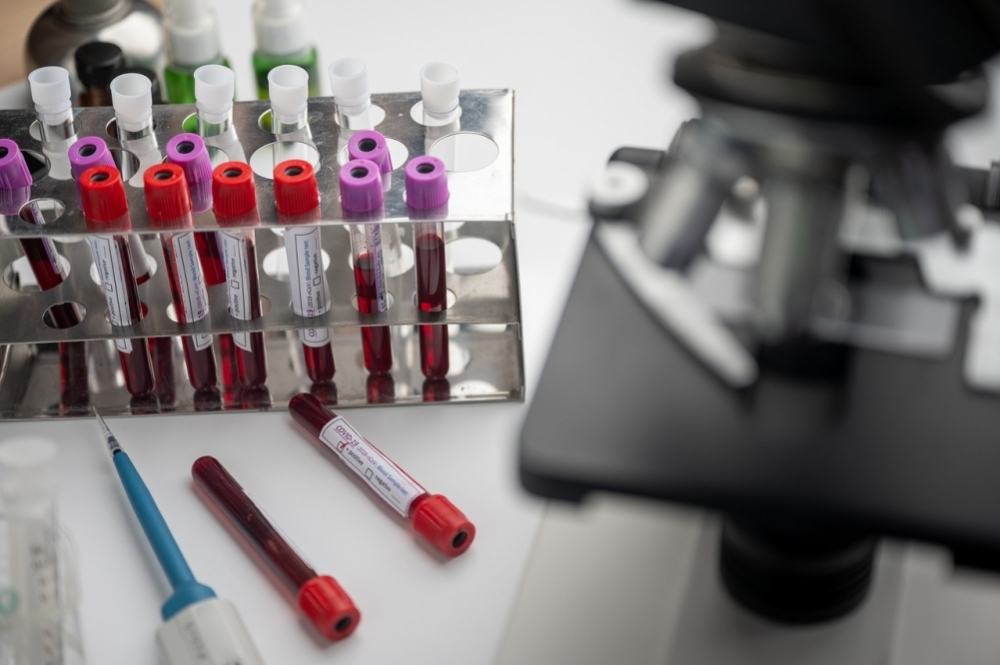


Researchers at the University of São Paulo identified proteins found at augmented levels in the blood plasma of high-risk patients using equipment present in Brazilian hospitals. The result of the test could help physicians make better-targeted decisions (photo: Chokniti Khongchum / Pixabay)
Published on 03/16/2021
By Karina Toledo | Agência FAPESP – A methodology developed by researchers at the University of São Paulo (USP) in Brazil can predict the risk of complications and hospitalization for COVID-19 patients simply by analyzing blood samples.
The analysis detects the proteins present in blood plasma to find out whether they display a pattern classified as high-risk by the researchers. The study, which was supported by FAPESP, is reported in an article posted to medRxiv, a preprint platform for new medical research that has not yet been peer-reviewed.
“We identified a group of molecules with significantly elevated plasma levels in patients with the severe form of COVID-19, particularly the proteins SAA1 and SAA2 [serum amyloid A1 and A2]. We propose that this plasma analysis be performed as soon as the patient is diagnosed by means of RT-PCR testing. If the sample displays the high-risk profile, the physician’s decisions can be better targeted,” Giuseppe Palmisano, a professor in the Biomedical Sciences Institute (ICB-USP) and principal investigator for the project, told Agência FAPESP.
He added, however, that more research is required to confirm the methodology’s prognostic power and clinical utility, via studies involving larger groups of patients in Brazil and elsewhere.
The findings reported in the article were based on analyses of blood samples from 117 COVID-19 patients treated in São Paulo City at the Heart Institute (INCOR) of Hospital das Clínicas (HC), the hospital complex run by the university’s Medical School (FM-USP), thanks to a collaboration with attending physicians Rinaldo Focaccia Siciliano and José Carlos Nicolau.
The volunteers who donated blood samples were matched for age, sex, and comorbidities (associated diseases such as diabetes, obesity, and high blood pressure) to assure comparability of the results. The proteins were identified by a microbiological technique known as matrix-assisted laser desorption/ionization time-of-flight mass spectrometry (MALDI-TOF MS), using a device found in most Brazilian hospitals. The technique can detect fungi and bacteria in blood or urine, for example, as well as determining the species of microorganisms.
“The technology is inexpensive and is already present in clinical practice, so it could be used rapidly for COVID-19 prognosis,” Palmisano said. “The equipment can analyze a protein profile for only 1 microliter of plasma, producing the result in under half an hour. The process can be automated to analyze samples from several subjects at the same time.”
Artificial intelligence
Six different machine-learning algorithms determined the plasma protein profile corresponding to high-risk and low-risk patients. The researchers used 88 of the 117 samples to train the software to distinguish between hospitalized (high-risk) patients and patients with mild symptoms when their blood samples were collected (low-risk).
The other 29 samples were used in a blind test to validate the method, confirming that the program performed the assessment correctly. The final accuracy rate (the probability of providing a correct result) was 93.1%, with 87.5% sensitivity (probability of true positive results) and 100% specificity (probability of true negative results).
“We found plasma protein profiles that were sufficiently different to separate the two groups of patients [hospitalized and with mild symptoms], which was very encouraging,” Palmisano said. “We then set out to identify the most abundant proteins in the high-risk group, and concluded that they were SAA1 and SAA2. Levels of these proteins in plasma from high-risk patients were also measured by other techniques, confirming the result obtained.”
Both SAA1 and SAA2 are produced in the liver and have inflammatory potential. “There’s a correlation between levels of these proteins and of some cytokines [pro-inflammatory molecules released by defense cells],” he explained. “According to studies reported in the literature, when blood levels of interleukin-1 [IL-1] and interleukin-6 [IL-6] increase, levels of these proteins, which are involved in the acute-phase inflammatory response, also increase.”
In addition to validating the test in a larger number of samples from patients hospitalized at INCOR and other groups, Palmisano added, it will be important to study how levels of these inflammatory proteins evolve during the course of the infection. “One of the things we want to understand is whether the concentration of these molecules declines in patients who succeed in controlling the disease and recover,” he said.
Different biomarkers
In another study conducted by groups at the University of São Paulo’s Ribeirão Preto School of Philosophy, Sciences and Letters (FFCLRP-USP) and the Federal University of São Carlos (UFSCar), the protein sTREM-1 was found to be a potential biomarker of the severity of COVID-19. In this case, blood levels of the molecule were measured by ELISA (enzyme-linked immunosorbent assay), which is based on antigen-antibody interactions detectable via enzymatic reactions (read more at: agencia.fapesp.br/34528).
In the analyses performed by Palmisano’s group using MALDI-TOF MS, sTREM-1 did not appear among the proteins differently regulated in high-risk patients. “We may have failed to find the same biomarkers because the technologies used in the studies are different, but it would be interesting to combine the two methodologies to try to arrive at a larger set of biomarkers that could produce an even more precise result,” Palmisano said.
The article “Prognostic accuracy of MALDI mass spectrometric analysis of plasma in COVID-19” can be read at: www.medrxiv.org/content/10.1101/2020.10.01.20205310v1.full.pdf.
Source: https://agencia.fapesp.br/34668